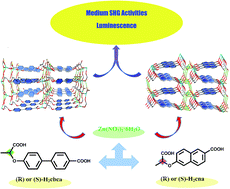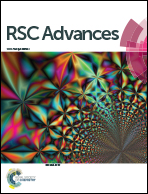Two pairs of Zn(ii) coordination polymer enantiomers based on chiral aromatic polycarboxylate ligands: synthesis, crystal structures and properties†
Abstract
Two pairs of Zn-based chiral coordination polymers (CCPs), namely, [Zn((R)-cbca)·H2O], [Zn((S)-cbca)]·H2O], [Zn((R)-cna)·2H2O] and [Zn((S)-cna)·2H2O] {H2cbca = (R) or (S)-4′-(1-carboxyethoxy)-[1,1′-biphenyl]-4-carboxylic acid, H2cna = (R) or (S)-6-(1-carboxyethoxy)-2-naphthoic acid} were synthesized under hydrothermal conditions. Their structures were determined by single-crystal X-ray diffraction analysis and further characterized by elemental analysis, infrared spectroscopy, powder X-ray diffraction, circular dichroism (CD) spectroscopy. CCPs 1–4 crystallized in chiral space groups and the CD spectra demonstrate obvious positive or negative Cotton effects. Second-harmonic generation (SHG) measurements show that CCPs 1–4 are SHG active and the SHG efficiencies are 0.6, 0.6, 0.5 and 0.5 times as much as that of urea, respectively. CCPs 1–4 exhibit relatively high luminescence properties originating from ligand centered emission.



 Please wait while we load your content...
Please wait while we load your content...